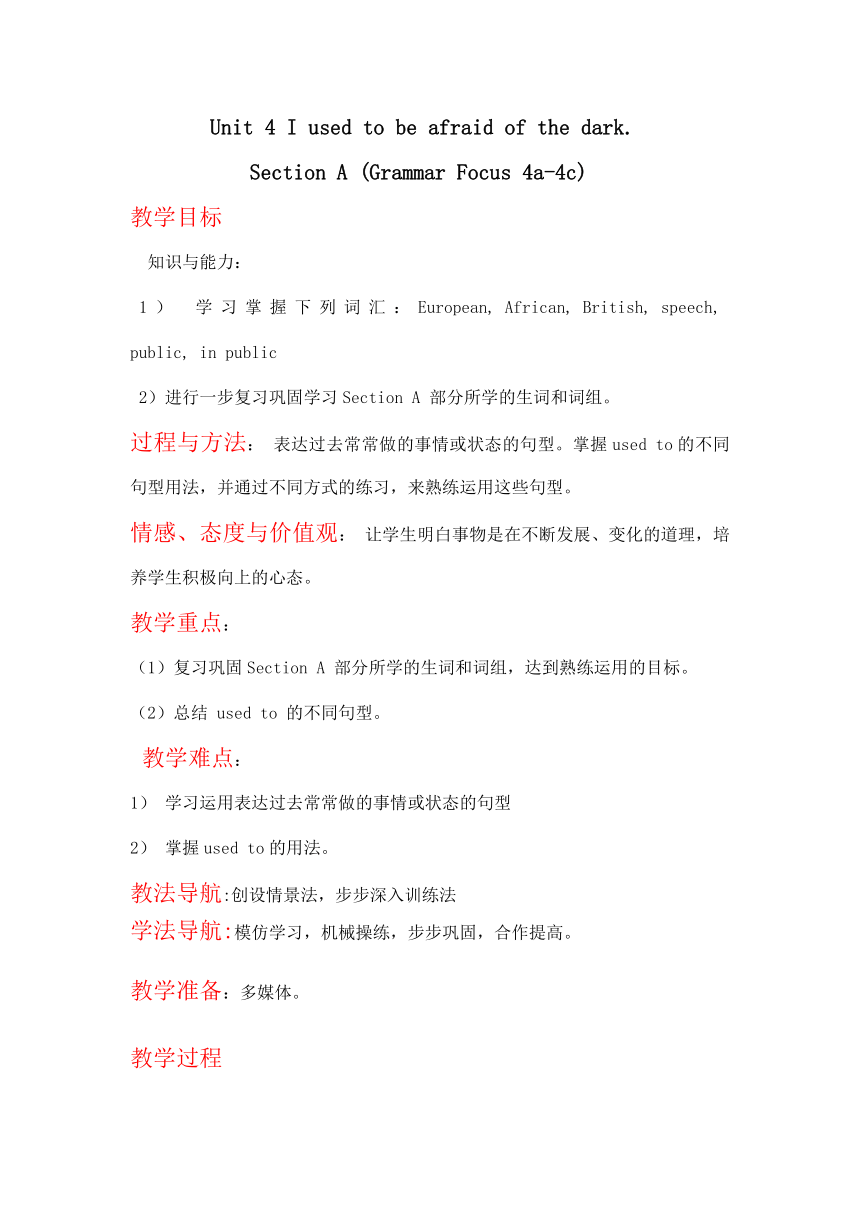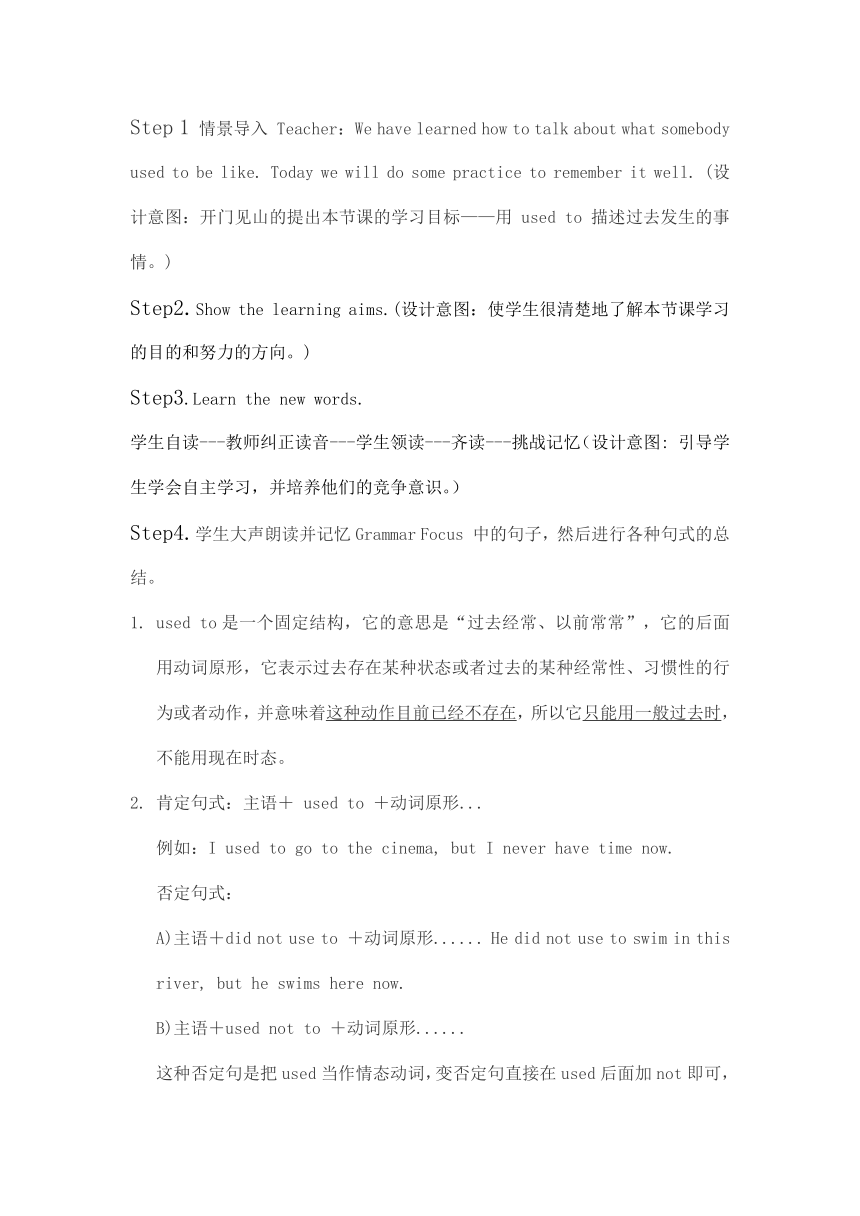人教版九年级全册英语Unit 4 .I used to be afraid of the dark.SectionA Grammar focus 4a-4c 教案
文档属性
| 名称 | 人教版九年级全册英语Unit 4 .I used to be afraid of the dark.SectionA Grammar focus 4a-4c 教案 |  | |
| 格式 | doc | ||
| 文件大小 | 61.5KB | ||
| 资源类型 | 教案 | ||
| 版本资源 | 人教新目标(Go for it)版 | ||
| 科目 | 英语 | ||
| 更新时间 | 2022-11-11 15:23:07 | ||
图片预览


文档简介
Unit 4 I used to be afraid of the dark.
Section A (Grammar Focus 4a-4c)
教学目标
知识与能力:
1) 学习掌握下列词汇:European, African, British, speech, public, in public
2)进行一步复习巩固学习Section A 部分所学的生词和词组。
过程与方法: 表达过去常常做的事情或状态的句型。掌握used to的不同句型用法,并通过不同方式的练习,来熟练运用这些句型。
情感、态度与价值观: 让学生明白事物是在不断发展、变化的道理,培养学生积极向上的心态。
教学重点:
(1)复习巩固Section A 部分所学的生词和词组,达到熟练运用的目标。
(2)总结 used to 的不同句型。
教学难点:
1) 学习运用表达过去常常做的事情或状态的句型
2) 掌握used to的用法。
教法导航:创设情景法,步步深入训练法
学法导航:模仿学习,机械操练,步步巩固,合作提高。
教学准备:多媒体。
教学过程
Step 1 情景导入 Teacher:We have learned how to talk about what somebody used to be like. Today we will do some practice to remember it well. (设计意图:开门见山的提出本节课的学习目标——用 used to 描述过去发生的事情。)
Step2.Show the learning aims.(设计意图:使学生很清楚地了解本节课学习的目的和努力的方向。)
Step3.Learn the new words.
学生自读---教师纠正读音---学生领读---齐读---挑战记忆(设计意图: 引导学生学会自主学习,并培养他们的竞争意识。)
Step4.学生大声朗读并记忆Grammar Focus 中的句子,然后进行各种句式的总结。
1. used to是一个固定结构,它的意思是“过去经常、以前常常”,它的后面用动词原形,它表示过去存在某种状态或者过去的某种经常性、习惯性的行为或者动作,并意味着这种动作目前已经不存在,所以它只能用一般过去时,不能用现在时态。
2. 肯定句式:主语+ used to +动词原形...
例如:I used to go to the cinema, but I never have time now.
否定句式:
A)主语+did not use to +动词原形...... He did not use to swim in this river, but he swims here now.
B)主语+used not to +动词原形......
这种否定句是把used当作情态动词,变否定句直接在used后面加not即可,used not 可以缩写成usedn’t。美式英语通常用A种形式,英式英语常用B种形式。例如:I used not to smoke a lot.
一般疑问句式:
A) Did +主语 +use to +动词原形...?
B) Used +主语+ to +动词原形...例如:
She used to smoke a lot.
Did she use to smoke a lot
Used she to smoke a lot
Used to 的反意疑问句
主语+used to do sth, didn’t +主语?/ used not+主语?
I used to be a teacher, didn’t you /used not you
He used to watch a lot of TV, didn’t he /used not he (设计意图:通过对 Grammar Focus 句型的分析能够使学生更好地理解和掌握本的重点语法和句型。)
Step5 拓展延伸
(1)used to do sth. 表示过去习惯性的动作或存在的状态。 to后跟动词原形,只用于一般过去时态。
(2)be used to + n./pron./doing 意为“习惯于……”,to是介词,后接名词、代词或动名词。可用于各种时态。
(3)get/become used to sth./doing sth. 意为“逐渐习惯于……”,强调这一习惯的过程,to是介词。
(4)be used to do 意为“被用来做……”,被动语态结构,to后跟动词原形。 be used for doing sth. 意为“被用来……”,介词for表示功能、用途。 (设计意图:相似知识点的拓展,很大程度上拓展了学生学习知识的范围,通过对比学习,又加深了他们对知识的理解与记忆。)
Step6. Finish the tasks 4a-4c
1.认真阅读 4a 中的例句,然后仿照例句完成剩余的句子,完成后教师点拨核对答案,学生大声朗读句子,掌握 used to 的否定句式。
2.认真阅读 4b 中的例句,用所给的信息仿照例句写句子,完成后小组内互相交流所写句子。
3.Group work, a student interviews the other students ahout the things, then write a report to finish 4c.(设计意图:通过此项活动,提高了小组之间的合作、探究以及交流能力。)
Step7.Do exercises
1. Did you ___ ___ (过去) play soccer
2. I _______ ____ ___ (过去不常) be popular in school.
3. Paula _____ ___ (过去常常) be really quiet.
用 used to 和 be used to 的适当形式填空。
1. My uncle ________ live in a big city but he ________ living in a village now.
2. I _______ get up late when I was in the middle school.
3. Her father is a teacher now. But he ________ be a worker.
4. I never go to school by bike. I __________ taking a bus to
(设计意图:通过本环节的学习,让学生对前一阶段所学的知识进行了复习和巩固)
板书设计:
否定句式:
A)主语+did not use to +动词原形......
B)主语+used not to +动词原形......
肯定句式:主语+ used to +动词原形...
一般疑问句式:A) Did +主语 +use to +动词原形...?
B) Used +主语+ to +动词原形...
反意疑问句 :主语+used to do sth, didn’t +主语?/ used not+主语?
Sb.be(get) used to doing sth. 某人习惯于做……
易错:Sb. be used to do/for doing sth. 某物被用于做
Used to的用法
Section A (Grammar Focus 4a-4c)
教学目标
知识与能力:
1) 学习掌握下列词汇:European, African, British, speech, public, in public
2)进行一步复习巩固学习Section A 部分所学的生词和词组。
过程与方法: 表达过去常常做的事情或状态的句型。掌握used to的不同句型用法,并通过不同方式的练习,来熟练运用这些句型。
情感、态度与价值观: 让学生明白事物是在不断发展、变化的道理,培养学生积极向上的心态。
教学重点:
(1)复习巩固Section A 部分所学的生词和词组,达到熟练运用的目标。
(2)总结 used to 的不同句型。
教学难点:
1) 学习运用表达过去常常做的事情或状态的句型
2) 掌握used to的用法。
教法导航:创设情景法,步步深入训练法
学法导航:模仿学习,机械操练,步步巩固,合作提高。
教学准备:多媒体。
教学过程
Step 1 情景导入 Teacher:We have learned how to talk about what somebody used to be like. Today we will do some practice to remember it well. (设计意图:开门见山的提出本节课的学习目标——用 used to 描述过去发生的事情。)
Step2.Show the learning aims.(设计意图:使学生很清楚地了解本节课学习的目的和努力的方向。)
Step3.Learn the new words.
学生自读---教师纠正读音---学生领读---齐读---挑战记忆(设计意图: 引导学生学会自主学习,并培养他们的竞争意识。)
Step4.学生大声朗读并记忆Grammar Focus 中的句子,然后进行各种句式的总结。
1. used to是一个固定结构,它的意思是“过去经常、以前常常”,它的后面用动词原形,它表示过去存在某种状态或者过去的某种经常性、习惯性的行为或者动作,并意味着这种动作目前已经不存在,所以它只能用一般过去时,不能用现在时态。
2. 肯定句式:主语+ used to +动词原形...
例如:I used to go to the cinema, but I never have time now.
否定句式:
A)主语+did not use to +动词原形...... He did not use to swim in this river, but he swims here now.
B)主语+used not to +动词原形......
这种否定句是把used当作情态动词,变否定句直接在used后面加not即可,used not 可以缩写成usedn’t。美式英语通常用A种形式,英式英语常用B种形式。例如:I used not to smoke a lot.
一般疑问句式:
A) Did +主语 +use to +动词原形...?
B) Used +主语+ to +动词原形...例如:
She used to smoke a lot.
Did she use to smoke a lot
Used she to smoke a lot
Used to 的反意疑问句
主语+used to do sth, didn’t +主语?/ used not+主语?
I used to be a teacher, didn’t you /used not you
He used to watch a lot of TV, didn’t he /used not he (设计意图:通过对 Grammar Focus 句型的分析能够使学生更好地理解和掌握本的重点语法和句型。)
Step5 拓展延伸
(1)used to do sth. 表示过去习惯性的动作或存在的状态。 to后跟动词原形,只用于一般过去时态。
(2)be used to + n./pron./doing 意为“习惯于……”,to是介词,后接名词、代词或动名词。可用于各种时态。
(3)get/become used to sth./doing sth. 意为“逐渐习惯于……”,强调这一习惯的过程,to是介词。
(4)be used to do 意为“被用来做……”,被动语态结构,to后跟动词原形。 be used for doing sth. 意为“被用来……”,介词for表示功能、用途。 (设计意图:相似知识点的拓展,很大程度上拓展了学生学习知识的范围,通过对比学习,又加深了他们对知识的理解与记忆。)
Step6. Finish the tasks 4a-4c
1.认真阅读 4a 中的例句,然后仿照例句完成剩余的句子,完成后教师点拨核对答案,学生大声朗读句子,掌握 used to 的否定句式。
2.认真阅读 4b 中的例句,用所给的信息仿照例句写句子,完成后小组内互相交流所写句子。
3.Group work, a student interviews the other students ahout the things, then write a report to finish 4c.(设计意图:通过此项活动,提高了小组之间的合作、探究以及交流能力。)
Step7.Do exercises
1. Did you ___ ___ (过去) play soccer
2. I _______ ____ ___ (过去不常) be popular in school.
3. Paula _____ ___ (过去常常) be really quiet.
用 used to 和 be used to 的适当形式填空。
1. My uncle ________ live in a big city but he ________ living in a village now.
2. I _______ get up late when I was in the middle school.
3. Her father is a teacher now. But he ________ be a worker.
4. I never go to school by bike. I __________ taking a bus to
(设计意图:通过本环节的学习,让学生对前一阶段所学的知识进行了复习和巩固)
板书设计:
否定句式:
A)主语+did not use to +动词原形......
B)主语+used not to +动词原形......
肯定句式:主语+ used to +动词原形...
一般疑问句式:A) Did +主语 +use to +动词原形...?
B) Used +主语+ to +动词原形...
反意疑问句 :主语+used to do sth, didn’t +主语?/ used not+主语?
Sb.be(get) used to doing sth. 某人习惯于做……
易错:Sb. be used to do/for doing sth. 某物被用于做
Used to的用法
同课章节目录
- Unit 1 How can we become good learners.
- Section A
- Section B
- Unit 2 I think that mooncakes are delicious!
- Section A
- Section B
- Unit 3 Could you please tell me where the restroom
- Section A
- Section B
- Unit 4 I used to be afraid of the dark.
- Section A
- Section B
- Unit 5 What are the shirts made of?
- Section A
- Section B
- Review of Units 1-5
- Unit 6 When was it invented?
- Section A
- Section B
- Unit 7 Teenagers should be allowed to choose their
- Section A
- Section B
- Unit 8 It must belong to Carla.
- Section A
- Section B
- Unit 9 I like music that I can dance to.
- Section A
- Section B
- Unit 10 You're supposed to shake hands.
- Section A
- Section B
- Review of Units 6-10
- Unit 11 Sad movies make me cry.
- Section A
- Section B
- Unit 12 Life is full of the unexpected
- Section A
- Section B
- Unit 13 We're trying to save the earth!
- Section A
- Section B
- Unit 14 I remember meeting all of you in Grade 7.
- Section A
- Section B
- Review of Units 11-14
